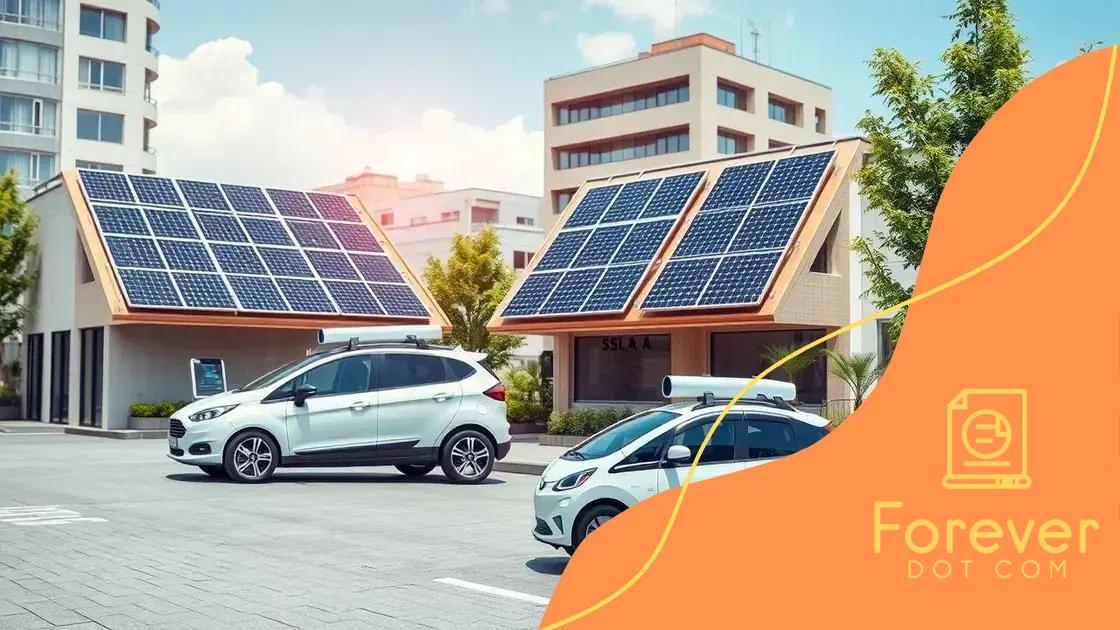Innovations in solar power technology in 2025

Innovations in solar power technology focus on advancements like higher efficiency solar panels, enhanced battery storage, and integration with smart systems, all supported by government incentives to promote renewable energy adoption.
Innovations in solar power technology in 2025 are set to transform the energy landscape, making solar solutions more efficient and accessible than ever. Have you considered how these advancements might impact your energy choices? Let’s dive into the latest developments.
Emerging trends in solar panel efficiency
The world of solar panel efficiency is evolving rapidly, driven by new technologies and innovative practices. As we look at emerging trends, it’s essential to understand how these advancements improve energy production and sustainability.
Advanced materials and technologies
One of the key components of increasing solar panel efficiency is the development of advanced materials. Scientists are researching solar cells made from perovskite, a material that has shown great promise in converting sunlight into energy. These cells can be cheaper to produce and more efficient than traditional silicon cells.
Performance optimization
Technologies like bifacial solar panels, which capture sunlight from both sides, are enhancing energy harvest. This means that panels can generate additional energy from reflections on the ground. Furthermore, tracking systems that adjust the angle of panels to follow the sun can lead to efficiency gains of up to 25%.
Key trends to look for:
- Increased conversion efficiency: Projects are aiming for efficiency rates above 25% through innovative designs.
- Integration with smart technology: Solar panels are now incorporating smart technology for real-time performance monitoring and adjustments.
- Efficient recycling methods: As more panels are deployed, the focus is shifting toward sustainable recycling of old panels.
Moreover, increased research into solar energy storage technologies is paving the way for enhanced performance during peak usage times. As we equip homes with battery systems, we maximize the use of collected energy, ensuring that sunlight collected during the day is readily available when demand rises in the evening.
Changes in regulatory frameworks and incentives are also playing a vital role. Governments are more frequently supporting advancements in solar panel technology, which encourages manufacturers to focus on efficiency as a priority. Additionally, customer awareness of sustainability is prompting companies to look for cutting-edge solutions.
In summary, with each passing year, the landscape of solar panel efficiency grows more exciting. Continued advancements will not only provide cleaner energy but also potentially lower energy costs for consumers.
The role of battery storage in solar technology
The role of battery storage in solar technology is increasingly important as we strive for a more sustainable energy future. With solar energy generation peaking during the day, batteries provide the crucial ability to store excess energy for use during non-sunny hours.
How batteries enhance solar systems
Battery storage systems allow homeowners and businesses to maximize their solar investments. Instead of relying solely on the grid, users can leverage stored energy to power their homes, even at night. This capability reduces dependency on fossil fuels and enhances energy independence.
Types of battery technologies
Different types of batteries serve varying needs in solar technology, and their efficiency and longevity are key factors. Some of the most common technologies include:
- Lithium-ion batteries: These are widely used due to their high energy density and long life cycle.
- Lead-acid batteries: While older technology, they are still used because of their lower cost, despite having shorter lifespans.
- Flow batteries: These newer systems promise longer duration storage, ideal for larger-scale solar projects.
Furthermore, innovative advancements in battery storage technology are emerging. For instance, solid-state batteries could potentially provide greater energy efficiency and are expected to become more mainstream. As these technologies improve, the cost of solar energy storage may continue to decline, making it accessible to more users.
As society transitions towards renewable energy, integrating batteries into solar solutions will become more critical. Policies encouraging such innovations are vital in facilitating this shift. In many regions, incentives for installing battery storage alongside solar panels are becoming increasingly common.
In addition to financial benefits, using battery storage with solar panels offers resilience against outages. When the grid fails, homes equipped with battery systems can continue to draw on stored energy. This aspect has gained significant importance as more extreme weather events challenge power infrastructure.
Innovations in solar energy applications

Innovations in solar energy applications are paving the way for a more sustainable future. These developments are not only making solar energy more efficient but also expanding its use in various aspects of daily life.
Solar energy in transportation
One groundbreaking application of solar energy is in transportation. Electric vehicles (EVs) are now being designed to incorporate solar panels. This means vehicles can harness sunlight to extend their range, providing an eco-friendly travel option. Beyond cars, solar-powered buses and even solar electric aircraft are being developed, showcasing the versatility of solar technology.
Innovative building designs
Another exciting area is the integration of solar technology in building designs. New construction techniques include solar panels as part of the facade or roof. This not only generates energy but also enhances the aesthetic appeal of buildings. Energy-efficient homes are equipped with solar water heaters and photovoltaic systems, helping owners save on energy costs while reducing their carbon footprint.
Key advancements to consider:
- Solar-powered smart gadgets: Devices like solar chargers and outdoor lights are gaining popularity, making it easier to live sustainably.
- Agricultural uses: Solar energy is used for irrigation systems and to power farm equipment, improving efficiency in farming.
- Energy for remote locations: In rural and isolated areas, solar energy applications are providing reliable power where traditional grids are not available.
In recent years, the focus has shifted to using solar energy in community projects as well. Solar panels are being installed in public spaces, parks, and schools, providing renewable energy while educating the public about sustainability. This accessibility encourages greater community involvement in green initiatives.
The advancements in solar energy applications highlight the significant impact solar technology can have across various sectors. As innovation continues, we can expect even broader adoption of solar solutions that promote sustainability and energy efficiency.
Government incentives for solar power adoption
Government incentives for solar power adoption play a crucial role in promoting renewable energy usage across the globe. These incentives not only help reduce the financial burden on consumers but also encourage the development of sustainable energy solutions.
Types of incentives available
Several types of government incentives exist to support individuals and businesses in adopting solar energy:
- Tax credits: Many countries offer tax credits that reduce the overall cost of solar installations. These credits can significantly lower upfront expenses, making solar energy more accessible.
- Grants and rebates: Some governments provide direct grants or rebates for solar panel installations. This financial support can substantially lower the initial investment required.
- Feed-in tariffs: In some regions, feed-in tariffs guarantee a fixed payment for the energy produced by solar panels. This ensures long-term financial returns for solar energy producers.
In addition to these incentives, many governments are establishing programs that simplify the process of acquiring solar panels. Streamlined permitting processes and standardized contracts can help potential adopters navigate the installation process more efficiently.
Benefits of government support
The push for solar power adoption through government incentives can lead to numerous benefits. Firstly, it promotes the reduction of greenhouse gas emissions, which contributes to combating climate change.
Secondly, the increased adoption of solar energy can create jobs in installation, manufacturing, and maintenance sectors. This job growth further stimulates local economies and encourages further investments in clean energy technologies.
Moreover, by making solar energy more accessible, governments contribute to energy independence. Reducing reliance on fossil fuels is vital for countries seeking to achieve energy security.
As governments worldwide recognize the importance of transitioning to renewable energy sources, the landscape for solar energy adoption continues to evolve. Encouraging further investment through incentives will be essential in realizing a sustainable energy future.
Future outlook: What’s next for solar technology?
The future outlook for solar technology is bright, showcasing exciting innovations and advancements on the horizon. These developments promise to enhance efficiency, affordability, and accessibility for consumers everywhere.
Emerging trends and technologies
One trend gaining momentum is the development of solar panels with higher efficiency rates. Researchers are focusing on new materials such as perovskites, which have the potential to outperform traditional silicon panels. This innovation could allow for smaller panels that generate more energy, effectively maximizing space on rooftops and solar farms.
Integrating solar with smart technology
Another fascinating area is the integration of solar technology with smart grids and home automation systems. These smart solutions help manage solar energy more effectively, allowing homeowners to monitor and optimize their energy usage in real time. Traditionally, homeowners had to rely strictly on grid energy, but with smart technology, they can now use their stored solar energy during peak hours, thus saving on energy costs.
Key developments to watch for:
- Battery innovations: As battery storage technology improves, solar energy can be stored more efficiently, providing power even during cloudy days or at night.
- More solar applications: Solar technology is expected to expand beyond electricity generation to applications like solar water heating, solar air conditioning, and even solar-powered vehicles.
- Affordable solar solutions: As production costs decline and government incentives continue, the affordability of solar panels will increase, making them accessible to more homeowners and businesses.
The role of governments in promoting solar energy will also evolve. More favorable regulations, combined with well-structured incentives, will support continued growth in the solar sector. As the demand for renewable energy increases, collaboration between governments, businesses, and communities will become vital.
Moreover, public awareness of climate change and the importance of sustainability will further accelerate the adoption of solar technology. As people recognize the benefits of reducing their carbon footprint, more homeowners are likely to invest in solar systems.
FAQ – Frequently Asked Questions about Solar Power Technology
What are the main benefits of adopting solar energy?
Adopting solar energy can reduce electricity costs, lower carbon footprints, and increase energy independence.
How do government incentives help with solar power adoption?
Government incentives, like tax credits and rebates, make solar panel installations more affordable, encouraging more people to switch to renewable energy.
What advancements are expected in solar technology in the coming years?
Future advancements include higher efficiency solar panels, better battery storage solutions, and the integration of solar technology with smart home systems.
Can solar energy be used in transportation?
Yes, solar energy is increasingly used in electric vehicles and public transportation systems, helping to reduce reliance on fossil fuels.






